�
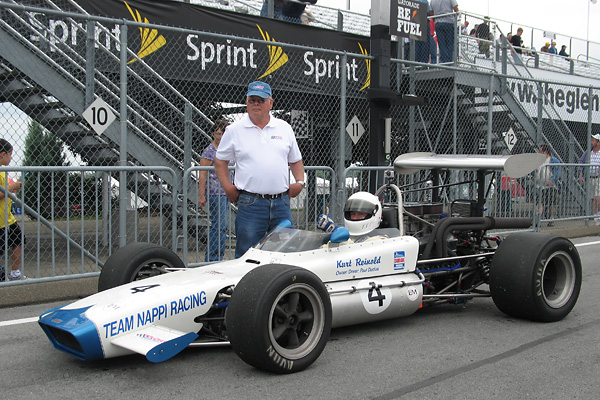
�
Paul Dudiak's McKee Mk12 Formula 5000 Racecar
� � Owner: Paul J. Dudiak� City: Peoria, Illinois
� Model: McKee Mk12 (circa 1969)
� Engine: Chevy 302cid V8
� Race prepared by: owner.�
�
McKee Engineering Corporation's Race Cars
��
Although Bob McKee is as American as the Indy 500, we can find a place for any �
McKee car on this "British Racecar" website. Bob is a pioneer and an innovator �
in so many respects that interest us. McKee Engineering Corporation was officially �
founded in 1961, shortly after 1959 Indy 500 winner Rodger Ward hired Bob to �
install a brand new Buick 215 aluminum V8 into a Cooper Monaco sports car. Ward's �
Cooper-Buick was the first technically successful installation of an American V8 �
into a rear-engined British racecar chassis. In the process, McKee solved one of �
the vexing challenges of the rear-engine arrangement by developing an economical �
transaxle that could take the stress of bigger engines and better racing tires. �
In short order, McKee Engineering sold about fifty transaxles to other car �
constructors, and among those customers was Carroll Shelby who specified the �
McKee transaxle into the Cooper/Shelby "King Cobra" racecars. Meanwhile, McKee�
Engineering was designing and building their own rear-engined racecars. As �
the Can-Am Series materialized, McKee cars were right in the mix. �
�
�
In 1968, McKee Engineering branched out to open-wheeled single-seaters. Their first �
"formula car" was the Mk8 model, for SCCA's Formula A class. Formula A cars were �
allowed to use engines of up to 5000cc displacement, although engines had to be homologated �
based on production of 1000 passenger cars. They were specifically required to utilize �
stock engine blocks and cylinder head castings, although bore and stroke could be changed�
freely. Two McKee Mk8's were built: one for Mak Kronn and the other for Kurt Reinold.�
The Mk12 of 1969 was essentially a development of the Mk8. Three were built, for �
drivers Kurt Reinold, Chuck Trowbridge and Dick DeJarld respectively. Although �
Formula A was itself a professional series, it was ultimately eclipsed in public �
perception by "Formula 5000", a higher profile and higher prize-money series that �
utilized the same technical regulations. In 1972 McKee Engineering built one final �
Formula A / Formula 5000 car, the Mk18 for driver Dick DeJarld. �
�
Bob McKee designed relatively tough, safe, and durable racecars. If you were to �
compare his work to more famous contemporaries, Ron Tauranac of Brabham �
might possibly come to mind. Like a Brabham, the Mk12 seems essentially practical and �
conservatively built. For example, every Heim joint seems at least one size larger �
than it might be if it were installed on a contemporary Lotus. (Among the advantages �
are that they might go a whole season without wearing out. Bob McKee wouldn't cut �
corners to build the lightest cars in their class.) On the other hand, McKee Engineering �
wasn't shy about utilizing new materials, new fabrication processes, and leading edge �
components. McKee preferred to use American-made components (e.g. brakes, steering�
rack, etc.) where feasible, and Bob McKee was particularly savvy about partnering �
with larger American companies to leverage their capabilities. Racing was the ideal �
place to demonstrate their newest technologies. �
�
�
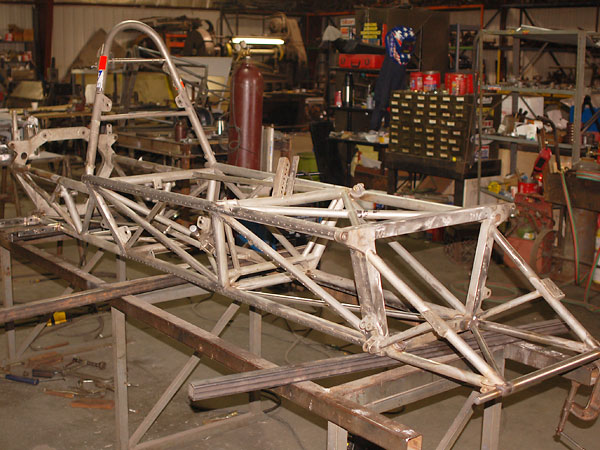
�
Mak Kronn's McKee Mk8 and Kurt Reinold's McKee Mk12 spaceframes were constructed of Grade 304
�
stainless steel, whereas other frames in these series were made of mild steel, except for the two tubes
�
per car which carried coolant. This photo shows Kurt Reinold's Mk12 during restoration by current owner
�
Paul Dudiak. Per a special request from Kurt Reinold, McKee included eight extra braces on this frame.
�
Which tubes are extra? Hint: they're mostly smaller (3/4") diameter. Answer: the tubes on either side of
�
the driver's waist (4), on either side of the drivers thighes (2), and above the driver's knees. (These
�
last two tubes turn a single diagonal brace into an "X" brace.) Probably superfluous, but not heavy...
�
�
In 1968 and 1969, Armco Steel Corporation¹ was a particularly important partner. �
This car and McKee Mk8 before it were essentially sponsored by Armco. The frames �
and most of the suspension components of these cars were constructed of Armco's Grade 304 �
stainless steel tubing, with TIG welded joints. In this time period, Armco was developing �
some very high strength stainless alloys. They provided all the stainless steel McKee �
Engineering could use - for free - and they encouraged experimentation. �
�
McKee used stainless for many, many parts. For example, the balljoint standoffs on �
Mk12 front spindle were made from "17-4 PH" stainless. Also known as Grade 630, this �
is a very high tensile strength stainless with the composition of 17% chromium, 4% nickel, �
4% copper and 0.3% niobium. The PH designation stands for "precipitation hardening." �
Its properties can be improved by a single, fairly low temperature heat treatment which �
causes no distortion of the component. Hub carrier bottom pivots were "13-8 Mo", which �
is another machineable and precipitation hardenable stainless steel. Its composition �
is 13% chromium, 8% nickel, 2% molybdenum. This is another high strength material, �
chosen because of its particularly high toughness and crack resistance.�
�
�
Enjoying this article? www.BritishRaceCar.com is partially funded through generous support from readers like you!
�
To contribute to our operating budget, please click here and follow the instructions.
�
(Suggested contribution is twenty bucks per year. Feel free to give more!)�
�
In exchange for free stainless steel, McKee Engineering made their brand new racecars �
available for various promotional purposes. Mak Kronn's Mk8 was displayed in the Armco�
booth at the Society of Automotive Engineers Congress in 1968. Armco removed the fiberglass �
bodywork, and displayed the complete chassis on specially constructed stands about forty �
inches off the floor. They also displayed specific example parts (such as the aforementioned �
hub carrier pivots) in other trade show displays. Kurt Reinold's Mk12 appeared in�
various Armco printed advertisements and brochures. �
�
McKee Engineering continued building racecars for other classes besides Formula 5000. �
One especially big project was a one-off, Armco-sponsored, four-wheel drive, twin �
turbocharged, aluminum-block Olds 455 powered Can-Am car. This technological tour de force �
featured a monocoque chassis of very thin gauge stainless steel. The car was completed, �
but unfortunately the sponsorship money ran out before it could be developed to its �
full potential. McKee Engineering has also accepted many interesting contracts outside �
of racing, including construction of special electric powered and military vehicles. �
The company continues to provide engineering and fabrication services from �
their 6000 square foot facility in Lake Zurick, Illinois. �
�
�
�
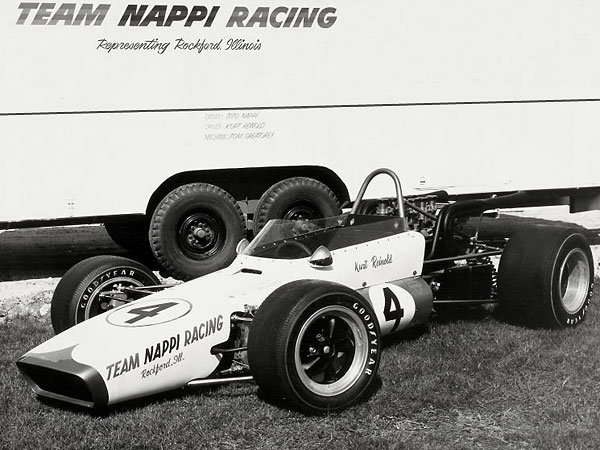
�
McKee Mk12c as delivered to Team Nappi Racing of Rockford, Illinois
�
Owner: Tito Nappi, Driver: Kurt Reinold, Mechanic: Tom Greatorex
�
Please support the sponsoring companies who make www.BritishRaceCar.com possible, including:
�
 �
�
Paul Dudiak's McKee Mk12
��
Paul Dudiak's 1969 McKee Mk12 was originally built-to-order for Tito Nappi, who owned �
Team Nappi Racing of Rockford, Illinois. The team's driver was Kurt Reinold, who drove�
it to eight SCCA Formula A National wins between 1969 and 1971. He also won numerous SCCA �
Divisional races and the SCCA Central Division Championship of 1970. He won the June �
Sprints race at Road America in 1971, and he set Formula A lap records at eight different �
venues. �
�
| SCCA Formula A National Victories: | ||
| August 24, 1969 | Blackhawk Farms, Illinois | |
| September 21, 1969 | Michigan International Speedway, Michigan | |
| October 5, 1969 | Indianapolis Raceway Park, Indiana | |
| August 23, 1970 | Blackhawk Farms, Illinois | |
| October 4, 1970 | Indianapolis Raceway Park, Indiana | |
| October 11, 1970 | Road Atlanta, Georgia | |
| June 20, 1971 | Road America, Wisconsin | |
| August 22, 1971 | Blackhawk Farms, Illinois | |
�
Kurt Reinold also occasionally entered Formula 5000 Championship Series races, where �
he raced the McKee Mk12 quite respectably against some of the more famous professional �
drivers of his time.
�
| Continental Championship Series Results: | ||
| May 4, 1969 | 6th place, Monterey Grand Prix | |
| July 6, 1969 | accident, Seattle Grand Prix | |
| July 20, 1969 | accident, Badger 200 (Road America) | |
| July 5, 1970 | accident, Dallas Grand Prix | |
| July 18, 1970 | 7th place², Road America Grand Prix | |
| September 7, 1970 | 11th place, Lime Rock Grand Prix | |
�
Tito Nappi sold the McKee Mk12 to C.J. Solomone in 1972. �
In 1973, ownership transferred to Anthony Kestian. �
From 1974 through 2005 the McKee was owned by Donald De Maagd.�
All these owners participated in SCCA Formula A races. �
The car was actively raced through September 1976.�
�
�
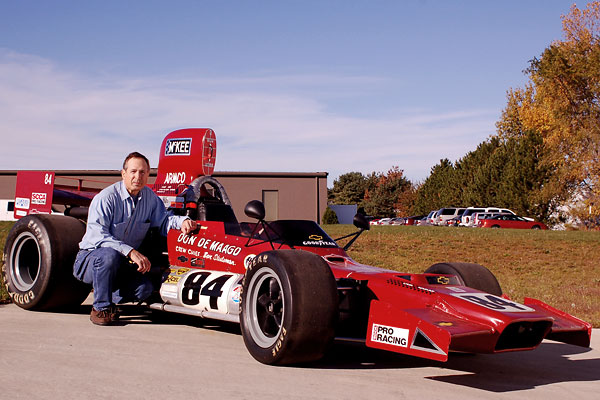
�
Paul Dudiak with his McKee Mk12c racecar in 2005, shortly after purchasing it from Donald De Maagd.
�
�
Paul Dudiak purchased the McKee in 2005, and completed its restoration in June 2006. �
Five companies assisted in the restoration: Prince Race Car Engineering of Sterling �
Illinois helped with the chassis and also built the wings. Mike Mullvain of Mullvain �
Motorsports in East Peoria rebuilt the engine. Gregg Elliff at GE Autosports of Avon �
Indiana rebuilt the transaxle. Hoerr Racing Products provided a multitude of parts.�
Carl Root repainted the bodywork. �
�
Paul has subsequently enjoyed driving the McKee Mk12 on twenty event weekends. �
Formula A and Formula 5000 cars are eligible to race with various vintage racing �
organizations. The Formula 5000 Drivers Association in particular organizes an exciting�
schedule of races, typically in cooperation with the Sportscar Vintage Racing Association �
(SVRA) and Historic Sportscar Racing (HSR). Paul participates in those events and has �
also raced with the Vintage Sportscar Driver's Association (VSCDA) and with the Monoposto�
Racing club.�
�
In early 2009, Paul Dudiak started an internet racing parts store called Dudiak Racing Products.�
�
Features and Specifications
�| Engine: | �Chevy 302cid (5.0L) V8, rebuilt by Mike Mullvain of Mullvain Motorsports. �
Dart Pro-1 aluminum cylinder heads. �
Inglese (McKay) intake manifold with 4 Weber IDA48 carburetors. �
K&N air cleaners.�
Vertex magneto ignition system. �
Taylor Pro Wire 8mm silicone insulated wire-core spark plug wires.�
Moroso dry sump oil pan. �
Peterson 4-stage dry sump oil pump, with gilmer drive pulleys.�
Peterson Fluid Systems oil reservoir (3 gallon) and oil breather tank.�
Fluidyne dual pass oil cooler.�
CM remote mount canister screen oil filter, and Fram HP4 oil filter. | �
| Cooling: | �Fluidyne custom aluminum radiator (nose-pod mounted). �
Harrison aluminum header tank. | �
| Exhaust: | �4-into-1 headers. | �
| Transaxle: | �Hewland LG600 6-speed, rebuilt by Gregg Elliff of GE Autosports. �
QuarterMaster 7.25" 3-disc clutch.�
Halfshafts with CV joints (inboard) and Cardan univeral joints (outboard). �
Stewart Warner transaxle oil cooler. Tilton clutch master cylinder. | �
| Front Susp.: | �McKee cast aluminum uprights. Gordon Schroeder (Schroeder Racing Products) steering rack.�
KONI 8212 double adjustable coilover shock absorbers. | �
| Rear Susp.: | �McKee cast aluminum uprights. KONI 8212 double adjustable coilover shock absorbers. | �
| Brakes: | �(master) dual Wilwood high-volume aluminum master cylinders, with bias bar. Motul fluid. � (front) 1967 Ford Mustang (Kelsey-Hayes) front calipers and (grooved) vented rotors. � (rear) 1967 Ford Mustang (Kelsey-Hayes) front calipers and vented rotors. | �
| Wheels/Tires: | �custom American Racing Torq-Thrust magnesium wheels (15x10 front, 15x15 rear). Avon tires (10.5x23.0x15 front, 15.0x26.0x15.0 rear). | �
| Electrical: | �Varley Red Top 30 racing battery. (No charging system.) �
Tilton Super Starter. | �
| Instruments: | �(left to right)�
AutoMeter coolant temperature gauge (140-280F),�
Stewart-Warner engine oil temperature gauge (100-270F),�
Stewart-Warner fuel pressure gauge (0-30psi), �
Jones mechanical tachometer (1000-10,000rpm),�
Steward-Warner oil pressure gauge (0-100psi). �
| �
| Fuel System: | �original dual 15 gallon Goodyear fuel cells. �
Dual Holley "blue" electric fuel pumps. �
Holley fuel pressure regulator. �
Dual System One billet aluminum fuel filters. | �
| Safety Eqmt: | �FireSense AFFF (foam) centralized fire suppression system.�
Crow Enterprises six point cam-lok safety harness.�
Personal steering wheel with Sweet Manufacturing quick release hub. �
50 LED rain light. | �
| Weight: | �1639 pounds with ~4 gallons of oil and ~20 gallons of fuel. � Corner weights (with body removed): LF:278#, RF:277#, LR:517#, RR:532#. Front/rear = ~35/65. | �
| Racing Class: | �Formula A and Formula 5000. | �
 �
�
�
�
Engine Installation
��
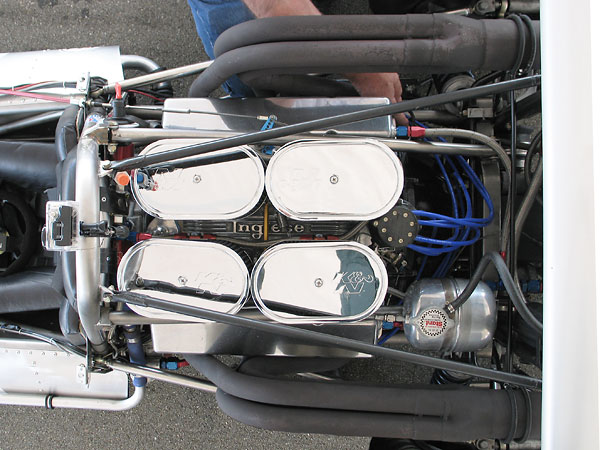
�
Inglese intake manifold for four Weber IDA48 downdraught carburetors.
�
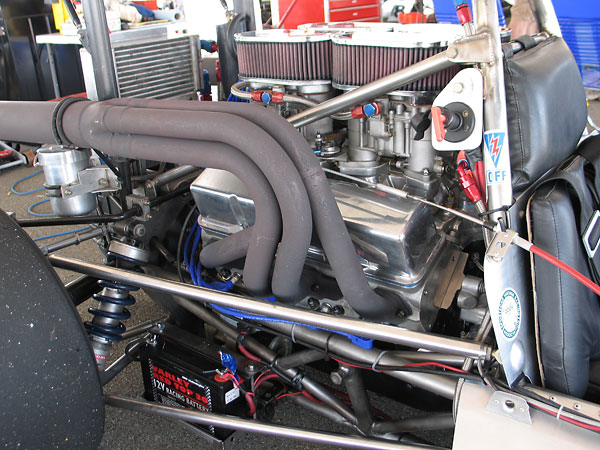
�
Paul's engine is rebuilt annually by Mike Mullvain of Mullvain Motorsports in East Peoria, Illinois.
�
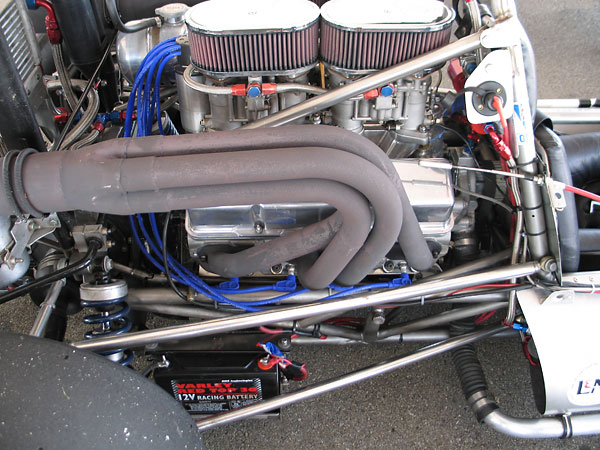
�
Regular small block Chevy four-into-one headers, installed upside down and reversed side-to-side.
�
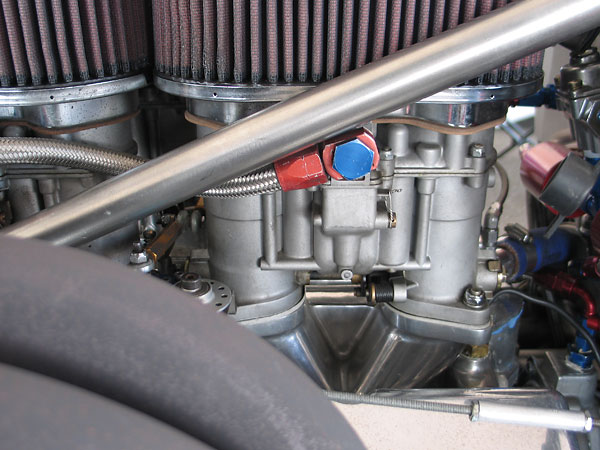
�
(How often do we see a photo of the back side of a Weber carburetor?)
�
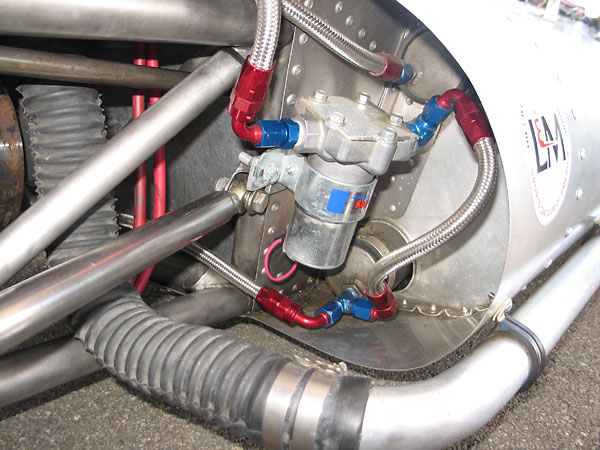
�
Holley "blue" electric fuel pump.
�
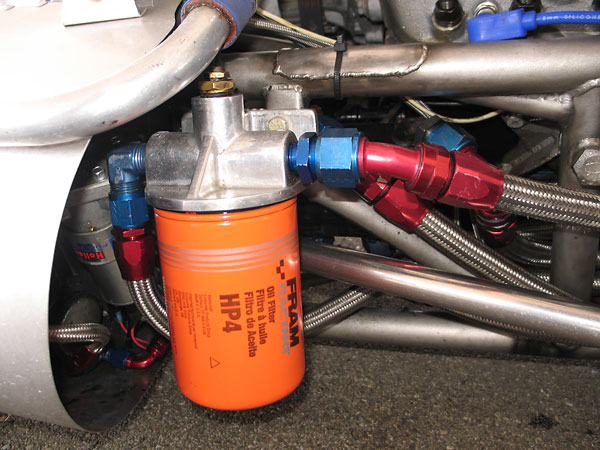
�
Fram HP4 oil filter on remote mount.
�
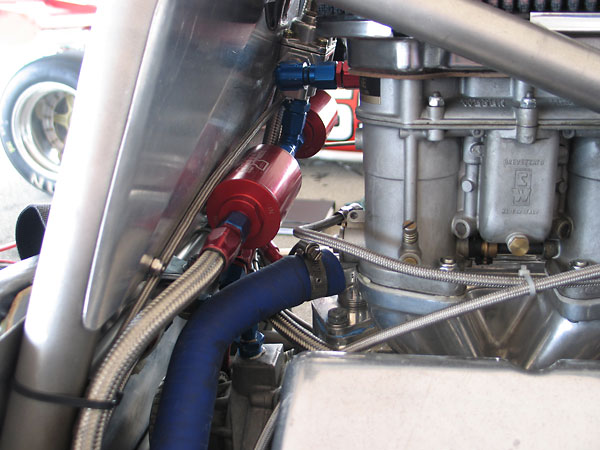
�
Dual "System One" billet aluminum fuel filters. Holley fuel pressure regulator.
�
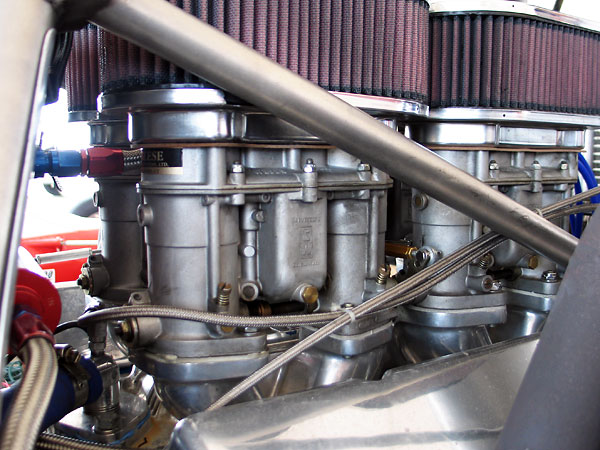
�
Four Weber IDA48 carburetors, with K&N gauze air filters.
�
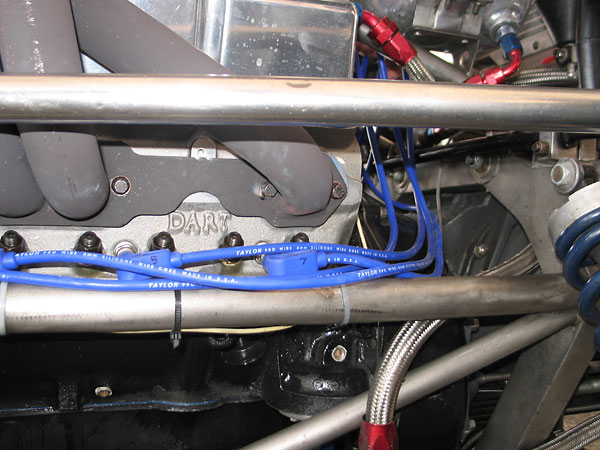
�
Dart Pro-1 aluminum cylinder heads.
�
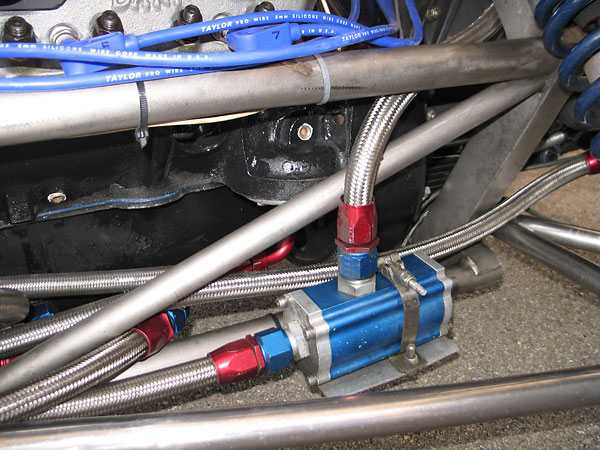
�
CM remote mount canister screen oil filter.
�
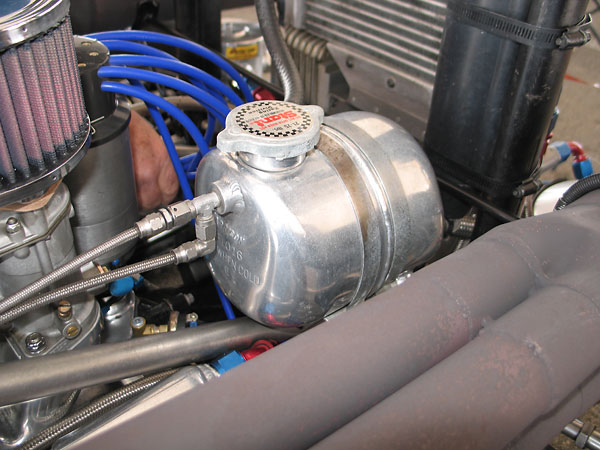
�
Harrison aluminum header tank.
�
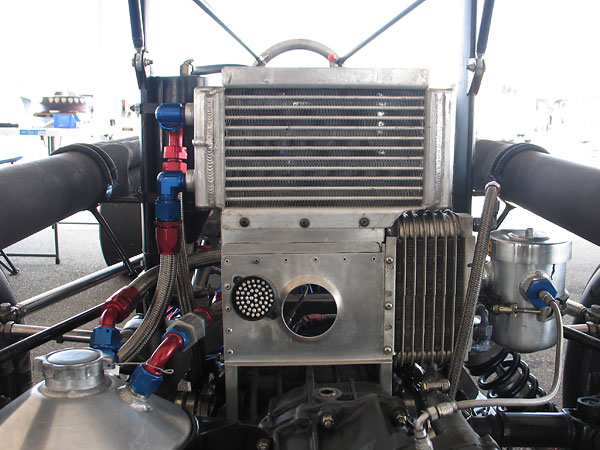
�
Fluidyne dual pass engine oil cooler, and vintage Stewart Warner transaxle oil cooler.
�
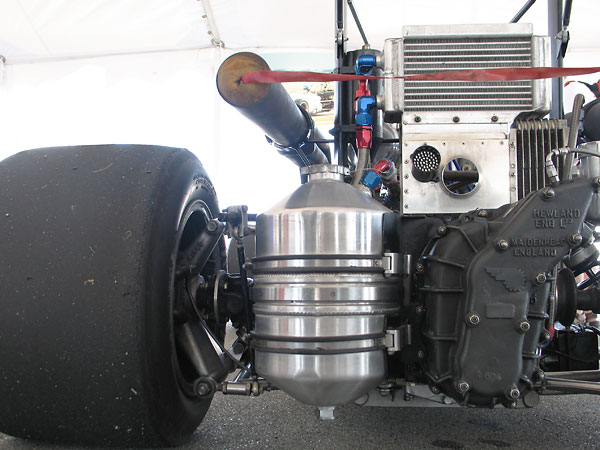
�
Peterson Fluid Systems oil reservoir (3 gallon).
�
Please support the sponsoring companies who make www.BritishRaceCar.com possible, including:
� �
 �
�
�
�
�
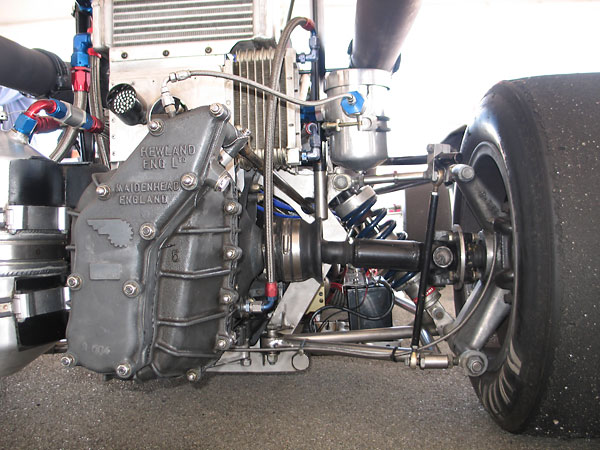
�
The Hewland LG600 6-speed transaxle (as shown here) was a popular choice in 1968 and '69.
�
After 1969, most Formula 5000 car constructors installed the lighter weight DG300 5-speed.
�
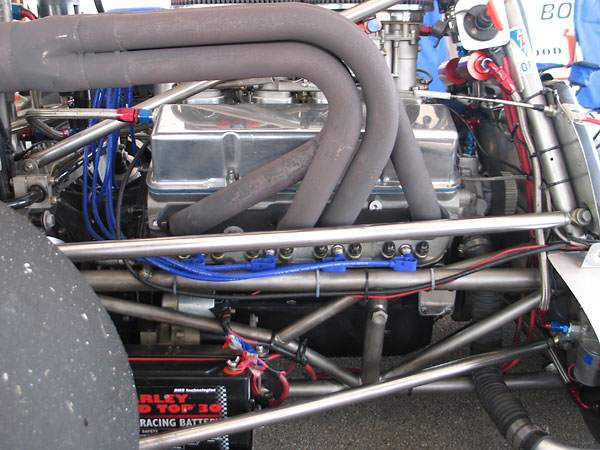
�
Varley Red Top 30 racing battery. Tilton Super Starter gear reduction starter.
�
�
Suspension / Etc.
��
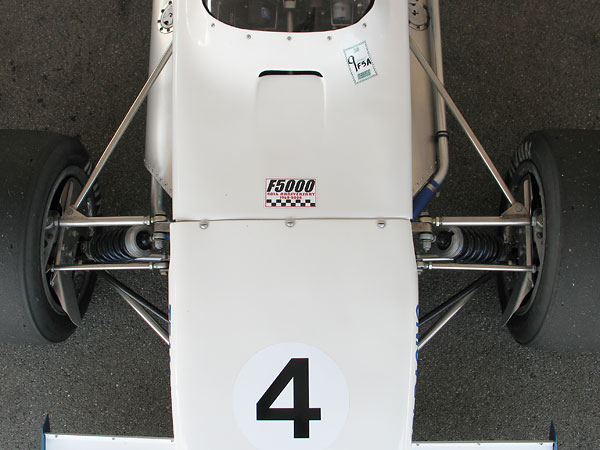
�
McKee Engineering found Grade 304 ("18/8") stainless steel is an excellent material for many fabricated
�
racecar suspension parts. Obviously it doesn't rust and it doesn't need to be painted. TIG welding 304 isn't
�
difficult, weldments don't need heat treatment (like Chrome Moly), and 304 isn't susceptible to hydrogen
�
embrittlement (like chromed parts.) Tensile strength is superior to mild steel. Possibly more importantly,
�
ductility is superior, so it's more fatigue resistant and less prone to cracking in minor accidents. It's easy
�
to inspect for cracks and to repair. Downside? Unless you're sponsored by Armco Steel, it's expensive.
�
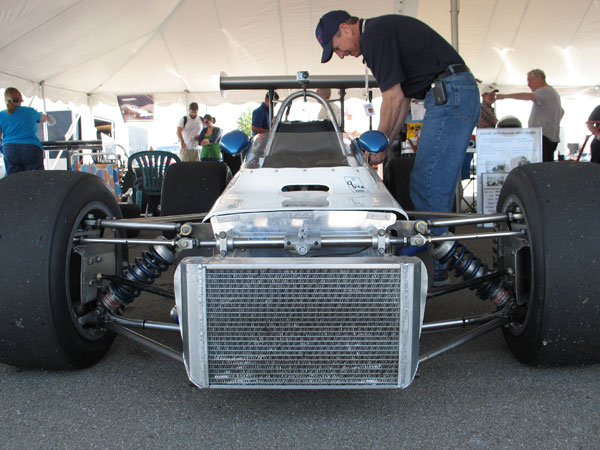
�
This custom aluminum radiator is a replacement. McKee Engineering made their own radiators. They bought
�
brass cores and then formed end tanks out of mild steel, fully-tinned on both interior and exterior surfaces.
�
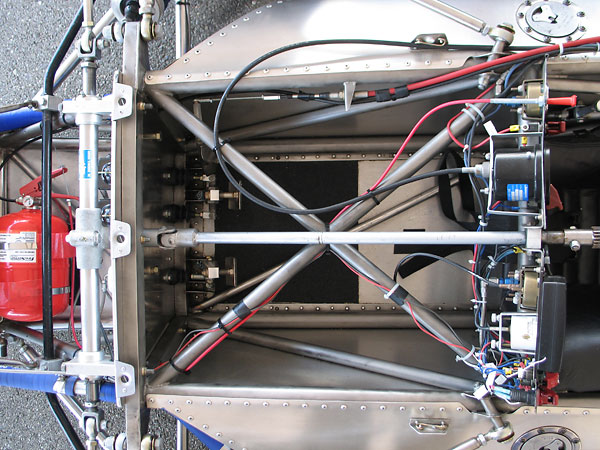
�
The floorpan and sides of the tub are aluminum, fully riveted to behave as stressed skins and give much of
�
the stiffness associated with monocoque construction. However, rather than rivet directly into main frame
�
longitudinal tubes, McKee tack-welded flange strips along the tubes and riveted to the flanges. Here, you
�
can see floorpan rivets just inboard of tubes. The trick is harder to spot along the top of the side panels.
�
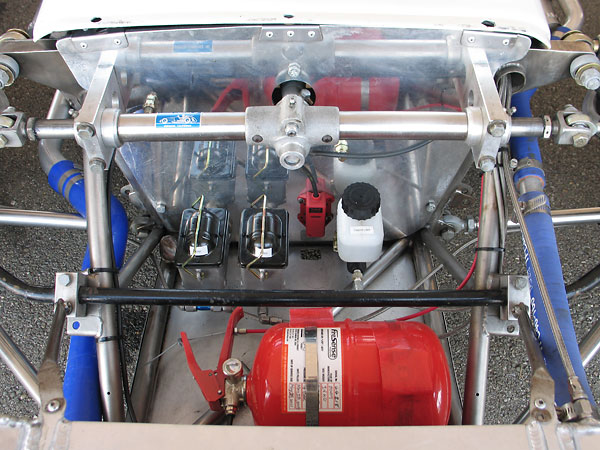
�
Near the upper right and lower left corners of the bulkhead, you can see where frame tubes used to carry
�
water to and from the radiator. (The lower tube is now capped off.) Lotus probably invented this nifty
�
weight-saving trick. Corrosion is an issue on old Lotus racecars that used this trick because Lotus didn't
�
use stainless steel frames! Kurt Reinold had external coolant plumbing added in 1969 to solve a different
�
problem: an unbearably warm cockpit.
�
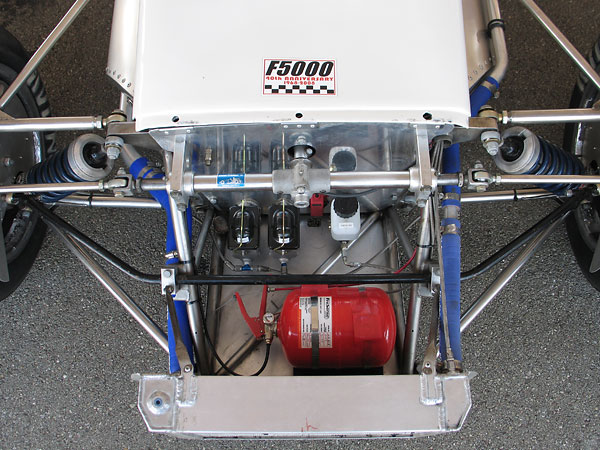
�
Dual Wilwood high-volume aluminum master cylinders, with bias bar. Tilton clutch master cylinder.
�
(The labels indicate that the brake system uses Motul brake fluid, and the clutch uses Castrol LMA.)
�
McKee originally installed Girling master cylinders. (On other cars they sometimes used Tiltons.)
�
The bulkhead they're mounted to is 0.25" magnesium. It adds a lot to the frame's torsional rigidity
�
The frame extends past the front bulkhead to support forward mounting points of the lower wishbones.
�
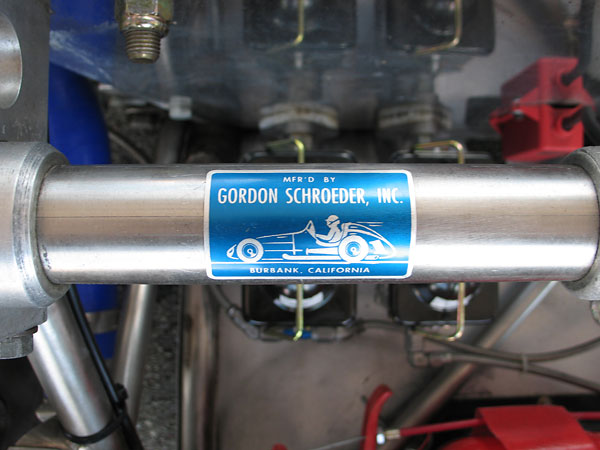
�
Gordon Schroeder Inc. steering rack. (The company has been renamed "Schroeder Racing Products".)
�
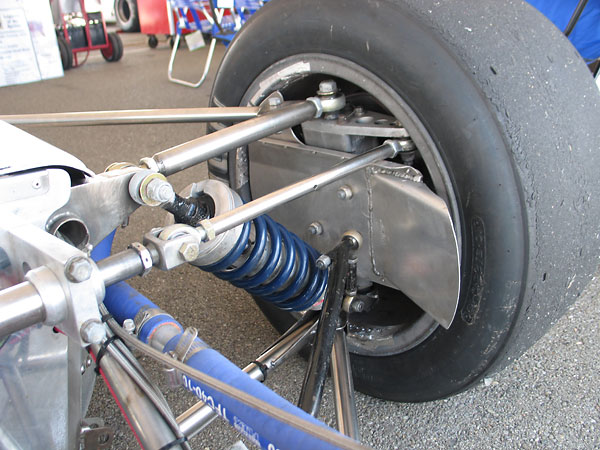
�
A brake cooling duct blocks our view of the Ford Mustang front brake caliper, vented rotor...
�
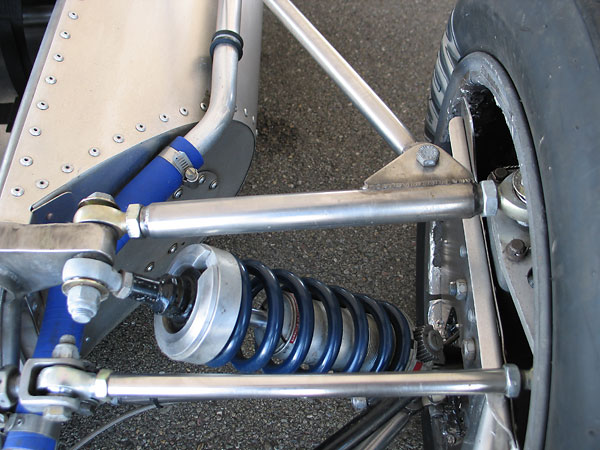
�
KONI 8212 double adjustable coilover shock absorbers. KONI invented the externally adjustable telescopic
�
shock absorber in the 1960's. KONI labeled their first adjustable model "8211". The 8211 features a steel
�
body. In 1967, KONI introduced the 8212 model which is similar except for its lightweight aluminum body.
�
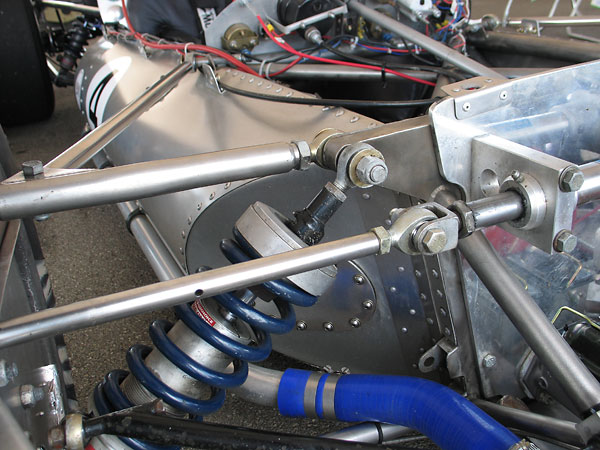
�
The tubular steering tie rods are simply threaded at each end to suit the Heim joints. To facilitate
�
tightening the jam nuts, holes have been drilled in the steering tie rods and a tool can be inserted,
�
but that's not the original design. (The hole is a stress riser.) Instead of a hole, the original tie
�
rods had hex-shaped sleeves silver-soldered to them for a crescent wrench to slip onto.
�
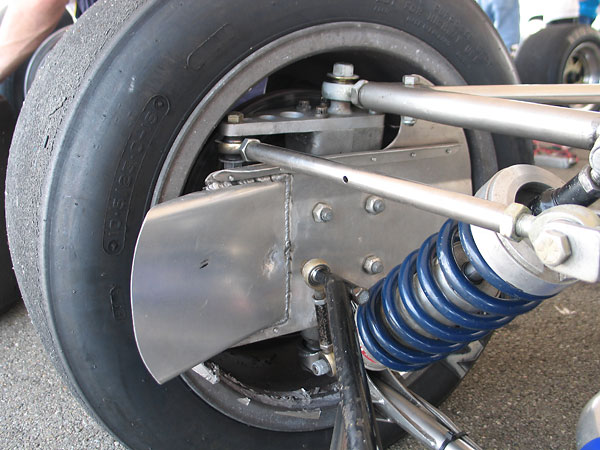
�
Anti-sway bar connection detail. Bob told us that if he were building these cars today, he'd probably
�
try heavier anti-sway bars, front and rear.
�
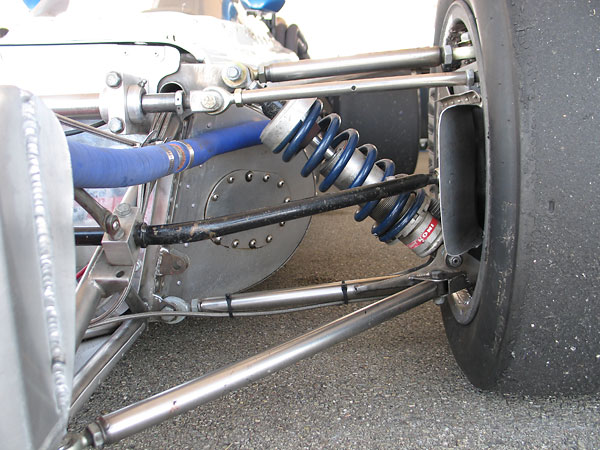
�
Notice the second (unused) mounting point for the rearward leg of the lower wishbone. Two positions were
�
provided to suit a range of driver preferences and track conditions, but the lower proved to work better.
�
There are a number of issues at play here: In the higher position, the suspension's roll center is higher,
�
which reduces the distance between roll center and center of gravity (i.e. "roll couple") and consequently
�
reduces body roll when cornering. Selection of the mounting position effects steering effort and steering
�
self-centering behavior. Most importantly, the two positions provide two different amounts of "anti-dive".
�
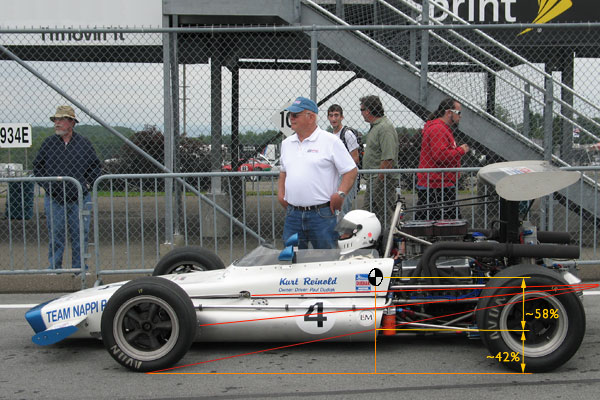
�
In 1969, anti-dive and anti-squat were still new concepts. After the Ford GT40, the McKee Mk12 was one
�
of the pioneering cars to have both anti-dive and anti-squat built in. In a nutshell, the principle of anti-dive
�
is that front suspension mounting points can be located strategically so the torque reaction of braking
�
partially cancels the suspension's tendency to plunge downward. Anti-squat is essentially the same thing,
�
except applied at the rear to help keep the car level under forward acceleration. Designers experimented
�
with anti-dive and anti-squat for better ride and to reduce camber and toe change, and their steering
�
effects which occur as cars take corners. But anti-dive in particular isn't something for nothing: too much
�
anti-dive causes cars to be "darty" and can make cars hypersensitive to bumps. It's a balance.
�
Modern racecars use very little anti-dive.
�
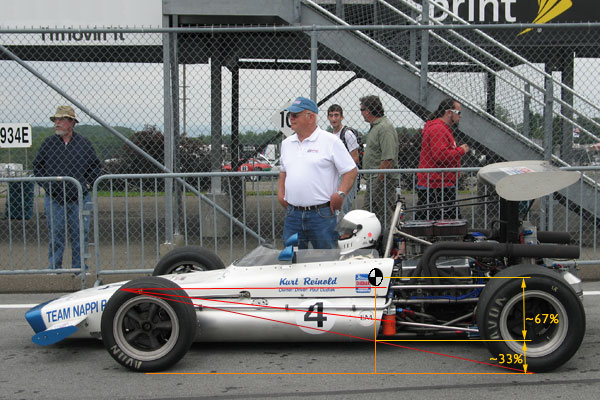
�
In principle, anti-dive and anti-squat effects can both be calculated by superimposing and then measuring
�
lines on side-view illustrations of a racecar. First, lines are drawn through suspension mounting points on the
�
chassis, and extended to where they converge. Then, a line is drawn back from the point of convergence to
�
the center of the tire contact patch. We're interested in where that line intersects the vertical plane of
�
the center of gravity. If it intersects exactly at the center of gravity, the suspension has 100% anti-dive
�
(or anti-squat) and no amount of braking (or acceleration) will cause the suspension to tilt the chassis.
�
With their very-powerful engines, Formula 5000 racecars could benefit from a lot of anti-squat.
�
�
Note: these two drawings show ~42% anti-dive and ~33% anti-squat respectively. Frankly, these numbers
�
are too large to be believable. The wheels obstructed our view of some of the suspension mounting points.
�
Also, our approximation of the center of gravity may be off. We would expect the anti-dive measurement to
�
be less than the anti-squat measurement, and both measurements should be less than 30%. We included
�
these sketches to show generally how you can tell by looking if a car has anti-dive and/or anti-squat built in.
�
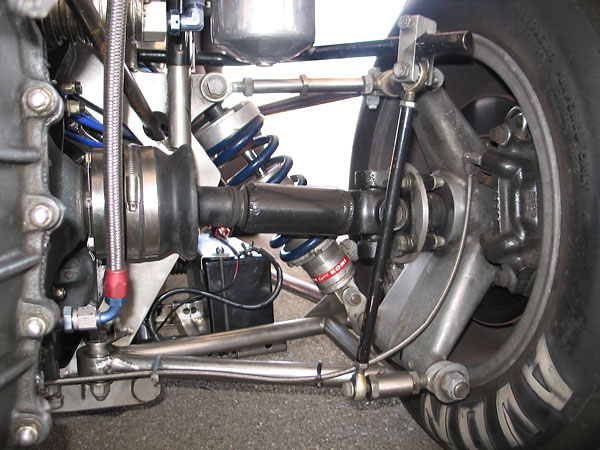
�
McKee cast aluminum uprights, and 1967 Ford Mustang iron brake calipers. The brake calipers aren't
�
as light as what other constructors put on Formula 5000 cars, but they saved customers a lot of money.
�
Retail replacement cost was about $18/each in 1969 dollars. Rotors were also inexpensive, and spares
�
could be purchased anywhere. McKee Engineering put the initial sets on their milling machine and cut
�
slots into them, or sometimes cross-drilled them. (Current configuration: slotted fronts & plain rears.)
�
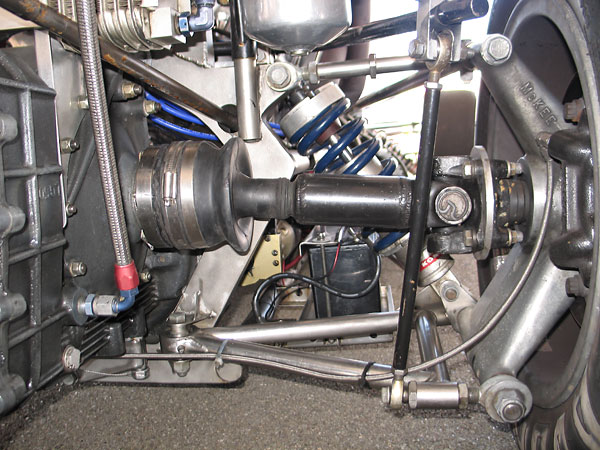
�
Dana (Rzeppa type) constant velocity joints on the inboard end of the halfshaft are original to the Mk12c.
�
They provide virtually frictionless axial plunge and true constant velocity. "Frictionless" is the key point.
�
Various attempts to use slip joints in the halfshafts had been unsuccessful because "stiction" makes it
�
difficult to smoothly apply power coming out of corners. (Binding here will cause oversteer, a.k.a. "push".)
�
Constant velocity? Regular universal joints cause continuously changing speed differentials between driving
�
and driven shafts as the angle of the joint changes. Result? Vibration caused problems elsewhere. CV
�
joints were a very rare feature on racecars until the 70's. They were expensive! Ford GT40 had them first.
�
�
Interior
��
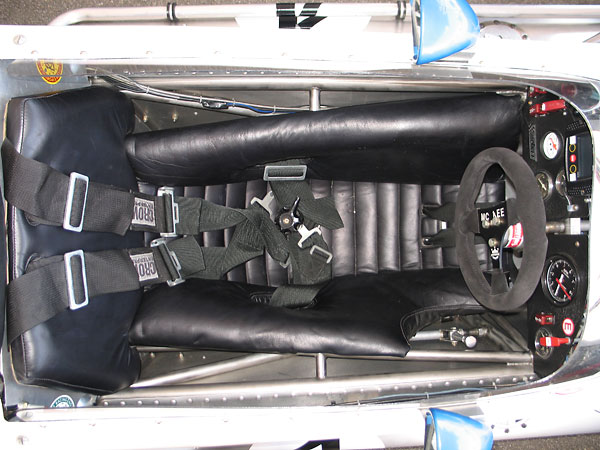
�
McKee Engineering custom fit each of their cars to its original driver. Kurt Reinold was pretty tall, so
�
Bob McKee spaced the front bulkhead forward by four inches on this particular car and also made a
�
custom seat for him. Since Paul Dudiak isn't so very tall, spacers have been removed to bring the front
�
bulkhead back to its original position. The original seat was removed and lost by a previous owner;
�
this one is a replacement. A Crow Enterprises six point cam-lock safety harness has been added.
�
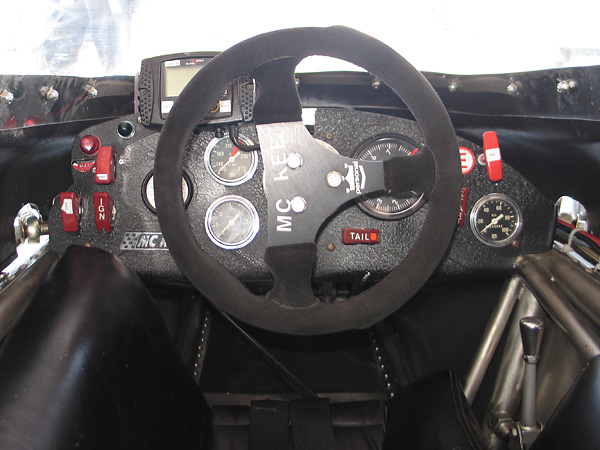
�
The switches are labeled: (left to right) "MAG", "TRANS", "IGN", "TAIL", "START", and "FIRE".
�
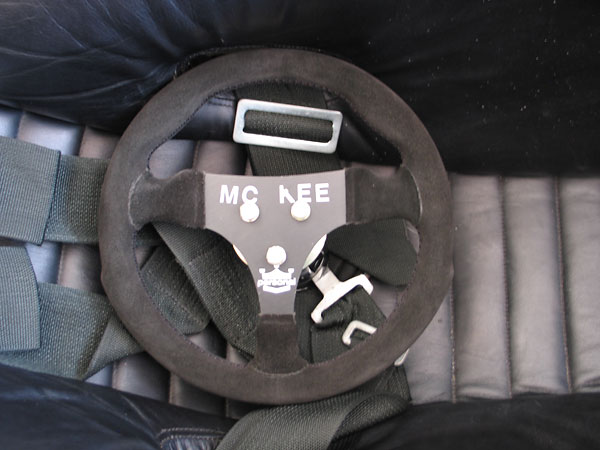
�
Personal steering wheel with Sweet Manufacturing quick release hub.
�
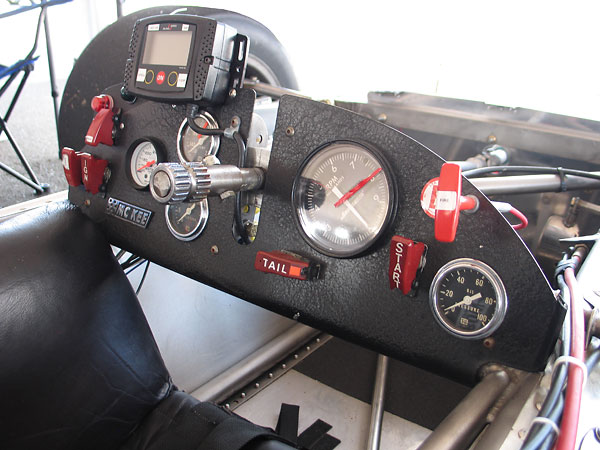
�
(left to right) AutoMeter coolant temperature gauge (140-280F), Stewart-Warner engine oil temperature
�
(100-270F), and fuel pressure gauge (0-30psi), Jones mechanical tachometer (1000-10,000rpm), and
�
Stewart-Warner oil pressure gauge (0-100psi).
�
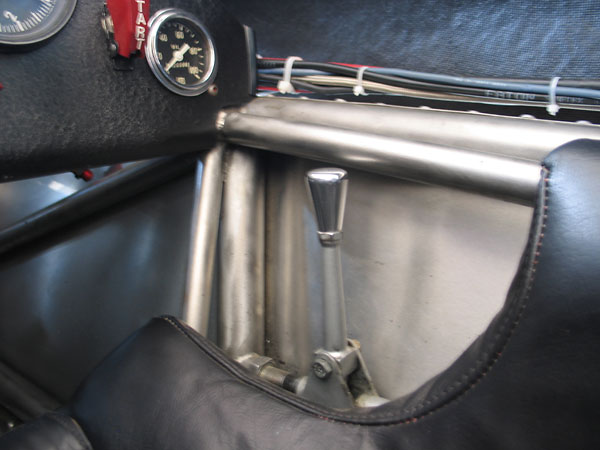
�
Gear selector lever, connected to the Hewland LG600 5-speed.
�
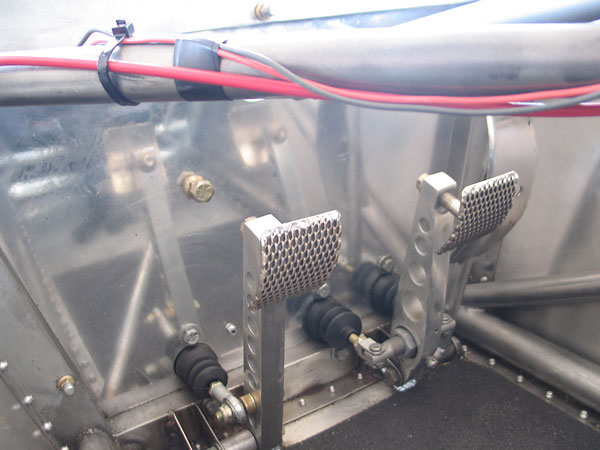
�
Back in the day, race car constructors made almost everything in-house. Even the pedals.
�
�
Exterior
��
�
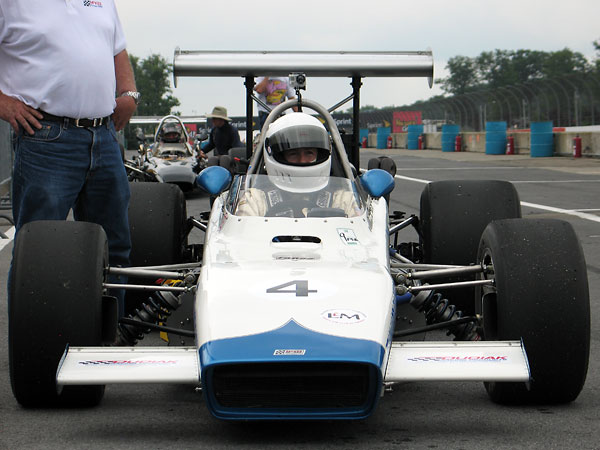
�
Paul Dudiak prepares for the start of the Formula 5000 feature race of the 2009 U.S. Vintage Grand Prix.
�
Paul finished sixth overall and second in the pre-1972 class. His best lap time was 2:04.106 (98.63mph).
�
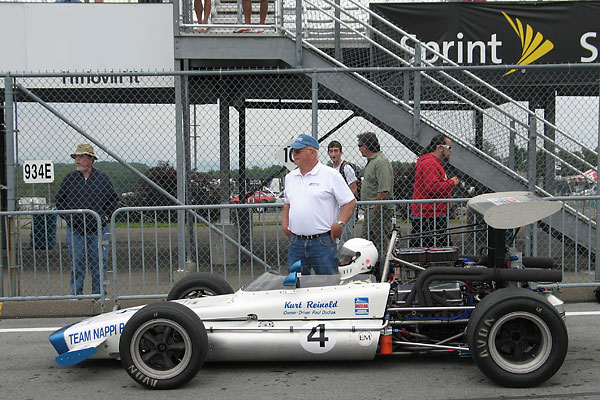
�
Bob McKee volunteered to serve as Crew Chief for Paul Dudiak at the 2009 U.S. Vintage Grand Prix.
�
Bob previously served as Crew Chief for Dick Rathman at the 1961 Indianapolis 500.
�
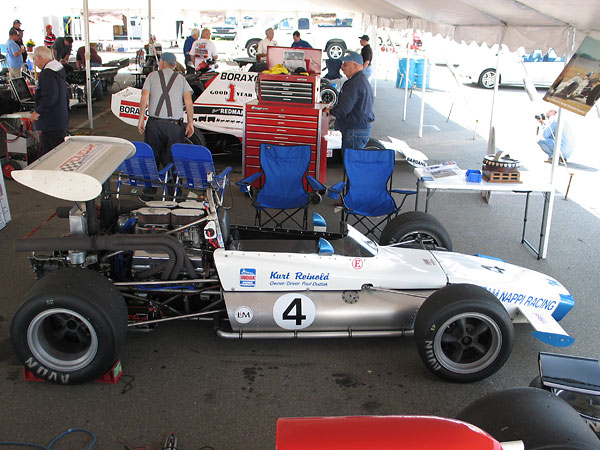
�
This is the second generation of front wing that Paul has installed on his McKee Mk12.
�
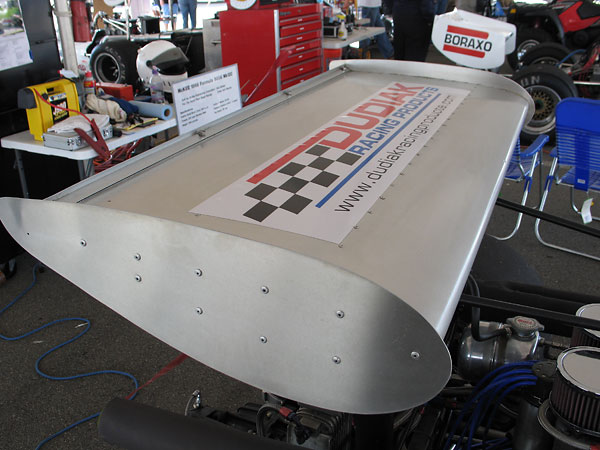
�
The McKee Mk12c has worn various rear wings over the years. It was originally delivered and raced without
�
any wings. In late 1969 the car carried a very high mounted wing. In 1970, the wing grew wider. The early
�
wings didn't have very aggressive profiles, they had no Gurney lips, and their end plates appeared slightly
�
smaller than shown here. However, by 1970 it was becoming apparent that high-mounted wings were causing
�
occasional accidents. A ban on high mounted rear wings started in 1970 for Canadian-hosted Formula A
�
races. In 1971, the ban on high mounted rear wings extended to the United States races too.
�
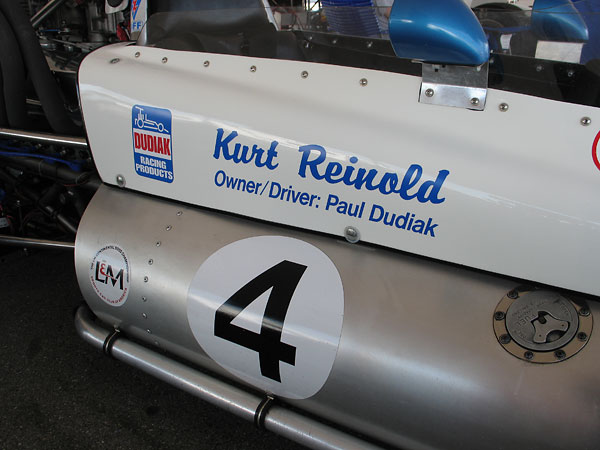
�
Kurt Reinold
�
Owner/Driver: Paul Dudiak
�
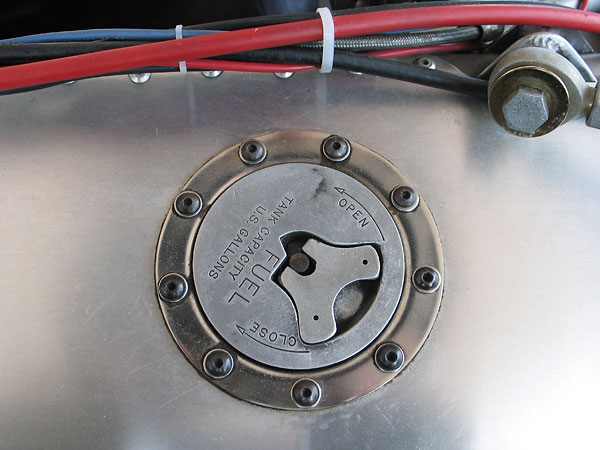
�
Recessed fuel filler cap... Goodyear made custom rubber fuel cell bladders for McKee Engineering,
�
They were interchangeable, left-to-right.
�
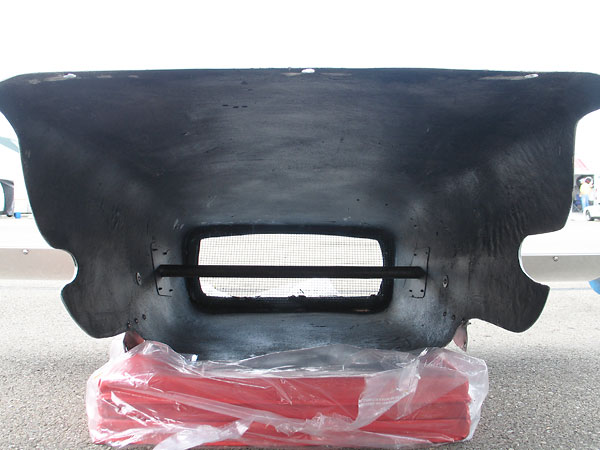
�
Nose cone construction details: the bar through the middle is for strength, and was added with the wings.
�
The nose cone mounts via three Dzus clips along the top and two forks attached low, along the sides.
�
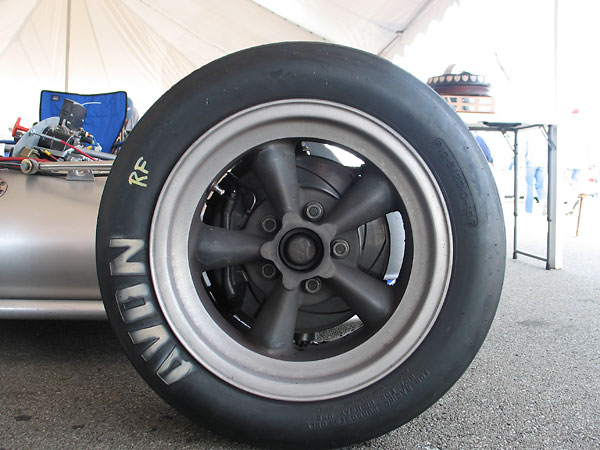
�
American Racing provided McKee Engineering with specially made versions of their famous Torq-Thrust
�
magnesium wheels (15x10 front, 15x15 rear). The front wheels had a custom backspacing (i.e. "offset"),
�
for a small, positive scrub radius. The rear wheels were also custom designed and made.
�
The only problem was that McKee Engineering had to buy their wheels in quantity.
�
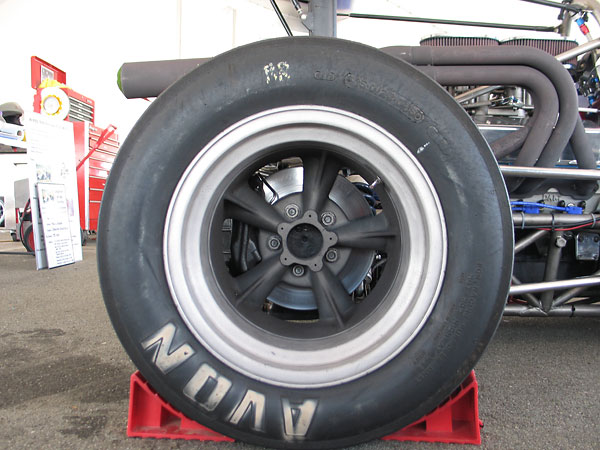
�
Goodyear tires were originally fitted because Goodyear provided them to McKee Engineering for free!
�
They apparently gambled that most teams would continue using whatever brand of tire originally came
�
on the car. That probably paid off, until recently... Avon tires (10.5x23.0x15 front, 15.0x26.0x15.0 rear).
�
| Notes: | |||||||
| (1) | �
American Rolling Mill Company was founded in 1899. Their name changed to Armco Steel Corporation�
in 1949. In about 1994 they merged with Kawasaki Steel Corporation to become AK Steel Holding �
Corporation, with AK Steel Corporation as their main operating division. �
� | ||||||
| (2) | �
Reinold's 7th place finish in 1970 earned him 4 championship points. With this score, �
he completed "The 1970 Continental Championship for Formula A Cars" in 27th place.�
This was indeed Formula 5000, but oddly the official name of the series didn't include �
the numeral 5000 yet. To eliminate fan confusion and improve marketing, this was �
corrected for 1971 and subsequent years: "1971 L&M Continental 5000 Championship", etc.�
Incidentally, the series' main sponsor was the Liggett and Myers cigarette company. �
In 1970, L&M guaranteed every race in the series would award at least $19,000 in �
prize money. In 1971, they raised the minimum purse to $35,000 per race... �
� | ||||||
�
The photos of the McKee Mk12 bare frame and of the McKee Mk12 as purchased in 2005 are both�
by Paul Dudiak, and are used here by exclusive permission. Copyright 2005. All rights reserved. �
The photo of the McKee Mk12 as received by Team Nappi is by Bob McKee, and is also used by�
exclusive permission. Copyright 1969. All rights reserved. �
All other photos are from September 2009 when the car appeared at The US Vintage Grand �
Prix at Watkins Glen. Photos by Curtis Jacobson and Don Moyer for BritishRaceCar.com. �
Copyright 2010. All rights reserved.
�
| If you liked this article, you'll probably also enjoy these: | �|||||
 | �
Ron Goldleaf '68 WRE Shadow | �
 | �
Mike Knittel '70 Chinook Mk12 | �
 | �
Eric Haga '70 Lola T190 | �
| You're invited to discuss anything you've seen here on The British Racecar Motorsports Forum! | �|||||
�
Notice: all the articles and almost all the photos on BritishRacecar.com are by Curtis Jacobson.
�
(Photos that aren't by Curtis are explicitly credited.) Reproduction without prior written permission is prohibited.
�
Contact us to purchase images or reproduction permission. Higher resolution images are optionally available.
�

 �
�